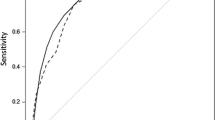Abstract
Background
Patients with early gastric cancer (EGC) who have undergone noncurative endoscopic resection (ER) generally require additional surgery due to the possibility of lymph node metastasis (LNM). This study aimed to develop a reliable risk-stratification system to predict LNM after noncurative ER for EGC.
Methods
A total of 2368 patients had a diagnosis of EGC and underwent ER. The study analyzed 321 patients who underwent additive gastrectomy and lymph node dissection after noncurative ER. Independent risk factors for LNM were identified and used to develop a risk-stratification system to estimate the relative risk of LNM.
Results
Of the 321 patients, 23 (7.2%) had LNM. A logistic regression analysis showed that female sex, lymphovascular invasion (LVI), and a positive vertical margin were significantly associated with LNM. The authors established a risk-stratification system using sex, LVI, and positive vertical margin (area under the receiver-operating characteristic [AUROC] curve, 0.811). The high-risk LNM group (score, ≥ 2 points) showed a significantly higher risk of LNM than the low-risk LNM group (score, <2 points) (14.0 vs 1.2%). No LNM was found in patients with a risk score of zero. After internal and external validation, the AUROC curve for predicting LNM was 0.788 and 0.842, respectively.
Conclusions
The risk-stratification system developed in this study will facilitate identification of patients who should undergo LN dissection after noncurative ER. Although additive surgery should be performed after noncurative ER for patients with a high risk of LNM, a close follow-up visit could be considered for low-risk patients with multiple comorbidities or high operative risks.


Similar content being viewed by others
References
Ono H, Kondo H, Gotoda T, et al. Endoscopic mucosal resection for treatment of early gastric cancer. Gut. 2001;48:225–9.
Rembacken BJ, Gotoda T, Fujii T, Axon ATR. Endoscopic mucosal resection. Endoscopy. 2001;33:709–18.
Japanese Gastric Cancer A. Japanese gastric cancer treatment guidelines 2010 (ver. 3). Gastric Cancer. 2011;14:113–23.
Isomoto H, Shikuwa S, Yamaguchi N, et al. Endoscopic submucosal dissection for early gastric cancer: a large-scale feasibility study. Gut. 2009;58:331–6.
Kusano C, Iwasaki M, Kaltenbach T, Conlin A, Oda I, Gotoda T. Should elderly patients undergo additional surgery after noncurative endoscopic resection for early gastric cancer? Long-term comparative outcomes. Am J Gastroenterol. 2011;106:1064–9.
Ohnita K, Isomoto H, Shikuwa S, et al. Early and long-term outcomes of endoscopic submucosal dissection for early gastric cancer in a large patient series. Exp Ther Med. 2014;7:594–8.
Choi J, Kim SG, Im JP, Kim JS, Jung HC. Long-term clinical outcomes of endoscopic resection for early gastric cancer. Surg Endosc. 2015;29:1223–30.
Noh H, Park JJ, Yun JW, et al. Clinicopathologic characteristics of patients who underwent curative additional gastrectomy after endoscopic submucosal dissection for early gastric cancer or adenoma. Korean J Gastroenterol. 2012;59:289–95.
Edge SB, Compton CC. The American Joint Committee on Cancer: the 7th edition of the AJCC cancer staging manual and the future of TNM. Ann Surg Oncol. 2010;17:1471–4.
Numata N, Oka S, Tanaka S, et al. Risk factors and management of positive horizontal margin in early gastric cancer resected by en bloc endoscopic submucosal dissection. Gastric Cancer. 2015;18:332–8.
Oka S, Tanaka S, Kaneko I, et al. Endoscopic submucosal dissection for residual/local recurrence of early gastric cancer after endoscopic mucosal resection. Endoscopy. 2006;38:996–1000.
Higashimaya M, Oka S, Tanaka S, et al. Outcome of endoscopic submucosal dissection for gastric neoplasm in relationship to endoscopic classification of submucosal fibrosis. Gastric Cancer. 2013;16:404–10.
Kim KY, Jeon SW, Yang HM, et al. Clinical outcomes of argon plasma coagulation therapy for early gastric neoplasms. Clin Endosc. 2015;48:147–51.
Tomita T, Arai E, Kohno T, et al. Outcomes of treatment of argon plasma coagulation therapy in elderly or high-risk patients with early gastric cancer: a comparison of outcomes among experienced and nonexperienced endoscopists. J Clin Gastroenterol. 2011;45:e54–9.
Choi JY, Jeon SW, Cho KB, et al. Noncurative endoscopic resection does not always lead to grave outcomes in submucosal invasive early gastric cancer. Surg Endosc. 2015;29:1842–9.
Hoteya S, Iizuka T, Kikuchi D, et al. Clinicopathological outcomes of patients with early gastric cancer after noncurative endoscopic submucosal dissection. Digestion. 2016;93:53–8.
Gotoda T, Sasako M, Ono H, Katai H, Sano T, Shimoda T. Evaluation of the necessity for gastrectomy with lymph node dissection for patients with submucosal invasive gastric cancer. Br J Surg. 2001;88:444–9.
Kim JH, Lee YC, Kim H, et al. Additive lymph node dissection may be necessary in minute submucosal cancer of the stomach after endoscopic resection. Ann Surg Oncol. 2012;19:779–85.
Acknowledgements
This research was supported by the Basic Science Research Program through the National Research Foundation of Korea (NRF) funded by the Ministry of Education, Science and Technology (2012R1A1A1042417).
Disclosures
All authors have no conflicts of interest or financial ties to disclose.
Author information
Authors and Affiliations
Corresponding authors
Additional information
Da Hyun Jung and Cheal Wung Huh have contributed equally to this work.
Electronic supplementary material
Below is the link to the electronic supplementary material.
Rights and permissions
About this article
Cite this article
Jung, D.H., Huh, C.W., Kim, JH. et al. Risk-Stratification Model Based on Lymph Node Metastasis After Noncurative Endoscopic Resection for Early Gastric Cancer. Ann Surg Oncol 24, 1643–1649 (2017). https://doi.org/10.1245/s10434-017-5791-9
Received:
Published:
Issue Date:
DOI: https://doi.org/10.1245/s10434-017-5791-9




